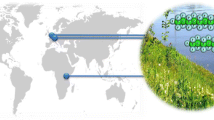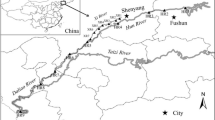Abstract
Background, Aim and Scope
In this paper recent results are provided of an investigation on the discovery of 12 perfluorinated surfactants (PS) in different surface and drinking waters (Skutlarek et al. 2006 a, Skutlarek et al. 2006 b). In the last years, many studies have reported ubiquitous distribution of this group of perfluorinated chemicals, especially perfluorooctane sulfonate (PFOS) and perfluorooctanoic acid (PFOA) in the environment, particularly in wildlife animal and human samples (Giesy and Kannan 2001, Houde et al. 2006, Prevedouros et al. 2006). Perfluorinated surfactants (e.g. PFOS and PFOA) have shown different potentials for reproductory interference and carcinogenity in animal experiments as well as partly long half-lives in humans (Guruge et al. 2006, FSA UK 2006a, FSA UK 2006b, 3M 2005, OECD 2002, Yao and Zhong 2005). They possess compound-dependent extreme recalcitrance against microbiological and chemical degradation and, in addition, they show variable potentials for bioaccumulation in animals and humans (Houde et al. 2006). Materials and Methods: Surface and drinking water samples were collected from different sampling sites: - Surface waters: samples taken from the rivers Rhine, Ruhr, Moehne and some of their tributaries. Further samples were taken from the Rhine-Herne-Canal and the Wesel-Datteln-Canal. - Drinking waters: samples taken in public buildings of the Rhine-Ruhr area. After sample clean-up and concentration by solid-phase extraction, the perfluorinated surfactants were determined using HPLC-MS/MS. Results: All measured concentrations (sum of seven mainly detected components) in the Rhine river and its main tributaries (mouths) were determined below 100 ng/L. The Ruhr river (tributary of the Rhine) showed the highest concentration (94 ng/L), but with a completely different pattern of components (PFOA as major component), as compared with the other tributaries and the Rhine river. Further investigations along the Ruhr river showed remarkably high concentrations of PS in the upper reaches of the Ruhr river and the Moehne river (tributary of the Ruhr) (Ruhr: up to 446 ng/L, Moehne: up to 4385 ng/L). The maximum concentration of all drinking water samples taken in the Rhine-Ruhr area was determined at 598 ng/L with the major component PFOA (519 ng/L). Discussion: The surface water contaminations most likely stem from contaminated inorganic and organic waste materials (so-called 'Abfallgemisch'). This waste material was legally applied to several agricultural areas on the upper reaches of the Moehne. Perfluorinated surfactants could be detected in some suchlike soil samples. They contaminated the river and the reservoir belonging to it, likely by superficial run-off over several months or probably years. Downstream, dilution effects are held responsible for decreasing concentrations of PS in surface waters of the Moehne and the Ruhr river. In analogy to the surface water samples, PS (major component PFOA) can be determined in many drinking water samples of the Rhine-Ruhr area where the water supplies are mainly based on bank filtration and artificial recharge. Conclusions: The concentrations found in drinking waters decreased with the concentrations of the corresponding raw water samples along the flow direction of the Ruhr river (from east to west) and were not significantly different from surface water concentrations. This indicates that perfluorinated surfactants are at present not successfully removed by water treatment steps. Recommendations and Perspectives: Because of their different problematic properties (persistence, mobility, toxicity, bioaccumulation), the concentrations of specific perfluorinated surfactants and their precursors in drinking waters and food have to be minimised. Therefore, it is of utmost importance to take the initiative to establish suitable legal regulations (limitations/ban) concerning the production and use of these surfactants and their precursors. Furthermore, it is indispensable to protect water resources from these compounds. A discussion on appropriate limit values in drinking water and foodstuffs is urgently needed. Concerning the assumed soil contamination, the corresponding regulation (Bioabfall-Verordnung 1998 – Regulation on Organic Waste 1998) should be extended to allow the control of relevant organic pollutants.
Similar content being viewed by others
Author information
Authors and Affiliations
Corresponding author
Rights and permissions
About this article
Cite this article
Exner, M., Färber, H. Perfluorinated Surfactants in Surface and Drinking Waters (9 pp). Env Sci Poll Res Int 13, 299–307 (2006). https://doi.org/10.1065/espr2006.07.326
Received:
Accepted:
Published:
Issue Date:
DOI: https://doi.org/10.1065/espr2006.07.326




